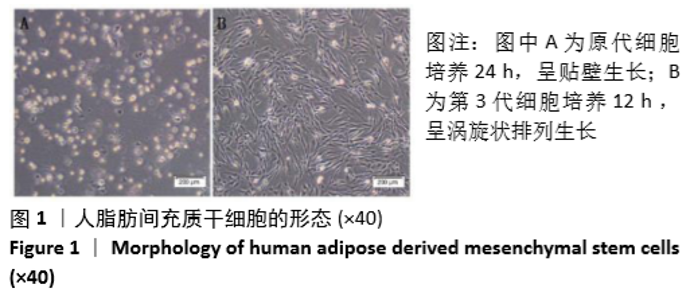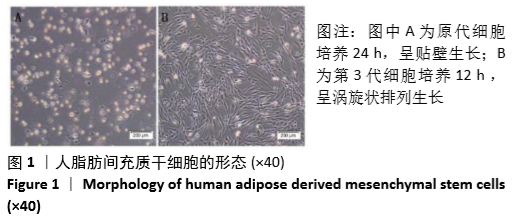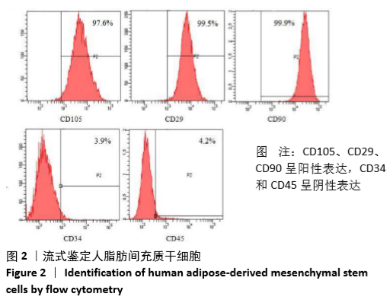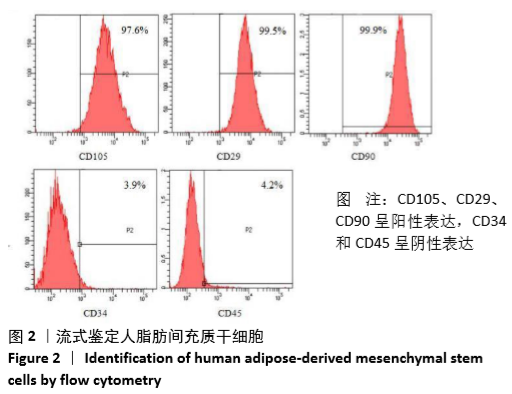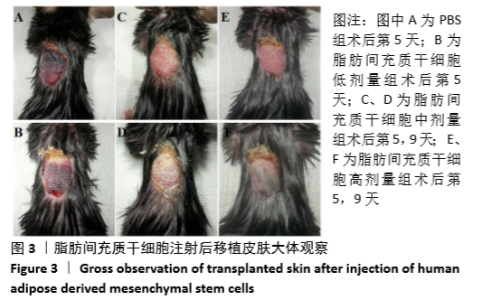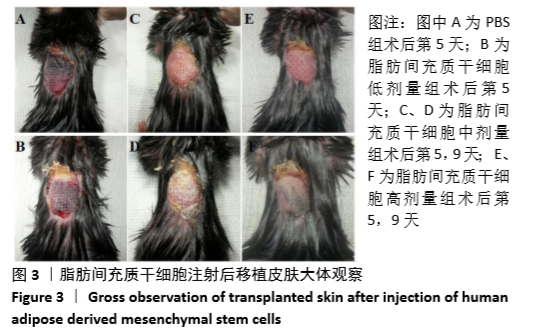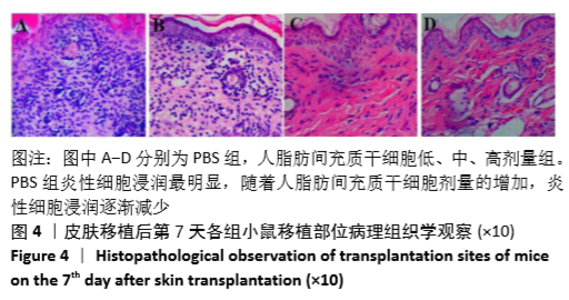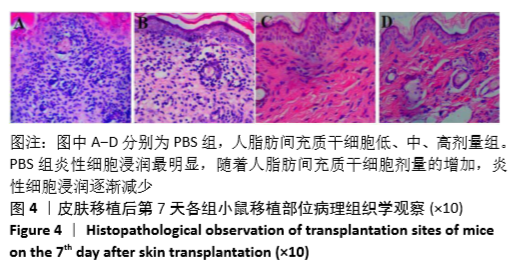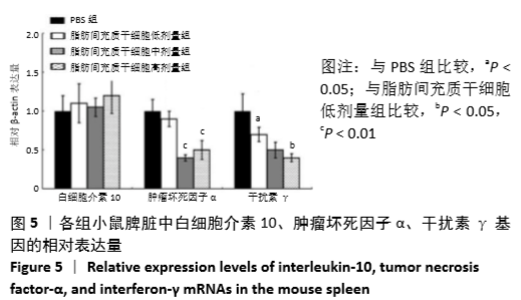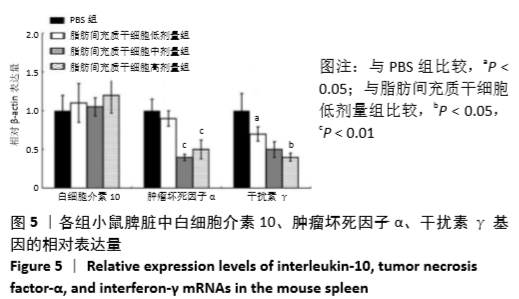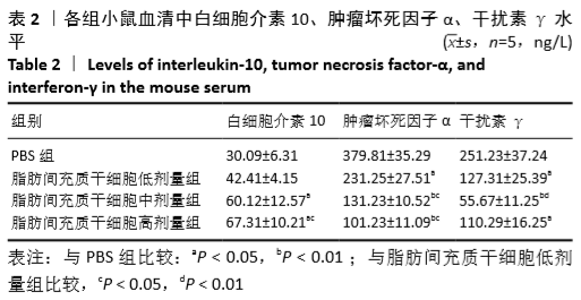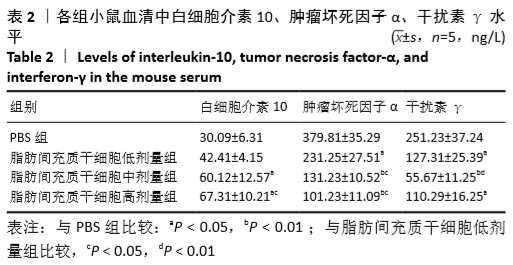[1] 汤沈力,谭秋雯,周宇婷,等.脂肪间充质干细胞在皮肤创伤修复中的研究进展[J].中国修复重建外科杂志,2017,31(6):745-750.
[2] 郝贵亮,解童玲,李玉奎,等.大鼠骨髓间充质干细胞对不同品系小鼠 移植皮肤存活时间的影响及机制[J].山东医药, 2017,57(37): 34-36.
[3] DAHER SR, JOHNSTONE BH, PHINNEY DG, et al. Adipose stromal/ stem cells: basic and translational advances: the IFATS collection. Stem Cells. 2008;26(10):2664-2665.
[4] ZUK PA, ZHU M, ASHJIAN P, et al. Human adipose tissue is a source of multipotent stem cells. Mol Biol Cell. 2002;13(12):4279-4295.
[5] TSUJI W, RUBIN JP, MARRA KG. Adipose-derived stem cells: Implications in tissue regeneration. World J Stem Cells. 2014;6(3):312-321.
[6] BAJEK A, GURTOWSKA N, OLKOWSKA J, et al. Adipose-Derived Stem Cells as a Tool in Cell-Based Therapies. Arch Immunol Ther Exp (Warsz). 2016;64(6):443-454.
[7] HIRSCH T, ROTHOEFT T, TEIG N, et al. Regeneration of the entire human epidermis using transgenic stem cells. Nature. 2017;551 (7680): 327-332.
[8] HODGES WM, O’BRIEN F, FULZELE S, et al. Function of microRNAs in the Osteogenic Differentiation and Therapeutic Application of Adipose- Derived Stem Cells (ASCs). Int J Mol Sci. 2017;18(12). pii: E2597.
[9] ASHRAF S, HAN IB, PARK H, et al. Role of RHEB in Regulating Differentiation Fate of Mesenchymal Stem Cells for Cartilage and Bone Regeneration. Int J Mol Sci. 2017;18(4). pii: E880.
[10] BERTOZZI N, SIMONACCI F, GRIECO MP, et al. The biological and clinical basis for the use of adipose-derived stem cells in the field of wound healing. Ann Med Surg (Lond). 2017;20:41-48.
[11] LEE SC, JEONG HJ, LEE SK, et al. Hypoxic Conditioned Medium From Human Adipose-Derived Stem Cells Promotes Mouse Liver Regeneration Through JAK/STAT3 Signaling. Stem Cells Transl Med. 2016;5(6):816-825.
[12] HSUEH YY, CHANG YJ, HUANG CW, et al. Synergy of endothelial and neural progenitor cells from adipose-derived stem cells to preserve neurovascular structures in rat hypoxic-ischemic brain injury. Sci Rep. 2015;5:14985.
[13] DAVY PM, LYE KD, MATHEWS J, et al. Human adipose stem cell and ASC-derived cardiac progenitor cellular therapy improves outcomes in a murine model of myocardial infarction. Stem Cells Cloning. 2015;8: 135-148.
[14] FORCALES SV. Potential of adipose-derived stem cells in muscular regenerative therapies. Front Aging Neurosci. 2015;7:123.
[15] BANYARD DA, SALIBIAN AA, WIDGEROW AD, et al. Implications for human adipose-derived stem cells in plastic surgery. J Cell Mol Med. 2015;19(1):21-30.
[16] RA JC, JEONG EC, KANG SK, et al. A Prospective, Nonrandomized, no Placebo-Controlled, Phase I/II Clinical Trial Assessing the Safety and Efficacy of Intramuscular Injection of Autologous Adipose Tissue-Derived Mesenchymal Stem Cells in Patients With Severe Buerger’s Disease. Cell Med. 2016;9(3):87-102.
[17] JURADO M, DE LA MATA C, RUIZ-GARCÍA A, et al. Adipose tissue-derived mesenchymal stromal cells as part of therapy for chronic graft-versus-host disease: A phase I/II study. Cytotherapy. 2017;19(8):927-936.
[18] 安媛,张铮,杜彬,等.低温保存对围生期间充质干细胞生物学特性的影响[J].中国医药导报,2017,14(2):4-7.
[19] BAER PC, GEIGER H. Adipose-derived mesenchymal stromal/stem cells: tissue localization, characterization, and heterogeneity. Stem Cells Int. 2012;2012:812693.
[20] LINDROOS B, SUURONEN R, MIETTINEN S. The potential of adipose stem cells in regenerative medicine. Stem Cell Rev Rep. 2011;7(2): 269-291.
[21] FRASER JK, WULUR I, ALFONSO Z, et al. Fat tissue: an underappreciated source of stem cells for biotechnology. Trends Biotechnol. 2006;24(4): 150-154.
[22] MCINTOSH KR, LOPEZ MJ, BORNEMAN JN, et al. Immunogenicity of allogeneic adipose-derived stem cells in a rat spinal fusion model. Tissue Eng Part A. 2009;15(9):2677-2686.
[23] 张文瑾,孙建军.人脂肪间充质干细胞的分离及培养和鉴定[J].临床耳鼻咽喉头颈外科杂志,2016,30(9):726-729.
[24] 郝贵亮,王立斌,陈冬梅,等.母体和胎儿来源的人胎盘间充质干细胞小鼠皮肤移植免疫排斥作用的比较[J].细胞与分子免疫学杂志,2015,31(5): 609-614.
[25] 方航荣,邱明链,刘景辛,等.IL-10基因修饰的树突状细胞诱导大鼠肝移植免疫耐受的实验研究[J].实用医学杂志, 2012,28(16): 2705-2708.
[26] MAHNKE K, JOHNSON TS, RING S, et al. Tolerogenic dendritic cells and regulatory T cells: a two-way relationship. J Dermatol Sci. 2007; 46(3):159-167.
[27] 高思海,李平,潘铁成,等.白细胞介素10基因转染抑制小鼠心脏移植排斥反应的实验研究[J].中华器官移植杂志, 2004,25(6): 349-350.
[28] SINGLA AK, GURRAM RK, CHAUHAN A, et al. Caerulomycin A suppresses immunity by inhibiting T cell activity. PLoS One. 2014; 9(10):e107051.
[29] TSAI SF, CHENG CY, SHU KH, et al. Trends in maintenance immunosuppressive drugs used in taiwanese kidney transplant recipients: an analysis of the national health insurance research database. Transplant Proc. 2012;44(1):190-192.
[30] GURRAM RK, KUJUR W, MAURYA SK, et al. Caerulomycin A enhances transforming growth factor-β (TGF-β)-Smad3 protein signaling by suppressing interferon-γ (IFN-γ)-signal transducer and activator of transcription 1 (STAT1) protein signaling to expand regulatory T cells (Tregs). J Biol Chem. 2014;289(25):17515-17528.
[31] SINGLA AK, GURRAM RK, CHAUHAN A, et al. Cerulomycin Caerulomycin [corrected] A: a potent novel immunosuppressive agent. Transplantation. 2014;97(9):e57-59.
[32] SHEN H, GOLDSTEIN DR. IL-6 and TNF-alpha synergistically inhibit allograft acceptance. J Am Soc Nephrol. 2009;20(5):1032-1040.
[33] BREHM MA, MANGADA J, MARKEES TG, et al. Rapid quantification of naive alloreactive T cells by TNF-alpha production and correlation with allograft rejection in mice. Blood. 2007;109(2):819-826. |
